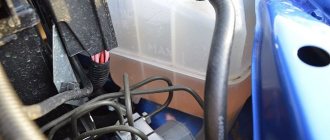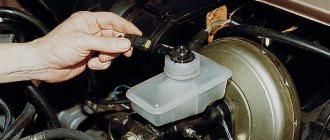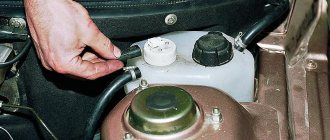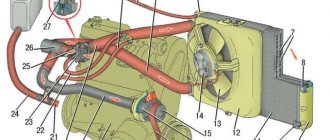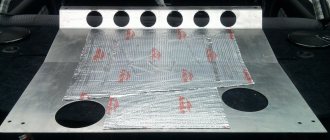In the vast majority of cases, it is very easy to find out the brand of antifreeze that was initially poured - just look at the sticker placed on the tank. This sticker always indicates in large letters the liquid with which the system was filled (and which it is recommended to add as needed).
In the vast majority of VAZ 2114 cars, the liquid filled at the factory is either Felix TC-40, produced in Dzerzhinsk, or CoolStream Standart 40, produced in Klimovsk. They can also be distinguished by color.
The first is bright green, the second is either green-yellow or faint green, in both cases there is slight fluorescence. Both of these liquids are antifreeze (belonging to class G11), and they can only be mixed with other liquids from this class.
Many people believe that Antifreeze is much worse in quality than antifreeze, so they cannot be mixed. This is incorrect - the reason lies not in the quality or acidity of the medium, but in the very different densities of these two liquids.
If it is not intended to replace the coolant with a liquid of a different category (for example, antifreeze for antifreeze), then you can add it without draining the entire cooling system. Otherwise, this operation will be strictly necessary.
Composition of antifreeze
This substance was developed in the USSR. For vases, moskvich and other domestic cars. The chemical composition and production technology have not changed over the years. The composition is as follows:
- Ethylene glycol;
- Distillate;
- Additives.
The secret is the composition of the additives, which should protect the system from corrosion and the pipes from destruction.
There are two types: blue (cyan) and red. Blue can be used in frosts up to 40 degrees, red - up to 65 degrees. In warm climates, dilution with water up to 50/50 is allowed, resulting in coolant for – 20 degrees and – 32 degrees, respectively.
Important: Ethylene glycol is poison. It is under no circumstances recommended to taste it or inhale the vapors. It is better to work with gloves, and if it gets on your skin, wash it off with soap and water.
Difficult choice between antifreeze and antifreeze
In order to choose the right coolant, it is recommended to study in detail the manufacturer’s manual, which most often states what type of coolant is intended for the car. Such instructions are always supported by successful tests of these compounds, specifically for each type of car engine. In addition, the recommendations may include a class of liquids that are produced using the following technologies:
- Traditional - coolant created using this technology contains additives from inorganic salts, such as nitrites, nitrates, phosphates, etc.
- Carboxylate - a coolant created using this technology already has additives from organic salts and carbonates, which interact much better with the internal parts of the engine.
- Hybrid - this technology was created to create a type of carboxylate technology with the addition of inorganic acids. This is done to reduce the cost of the final product.
As you can understand, antifreeze is a liquid created using traditional technology, and antifreeze is created using carboxylate technology, which has clear advantages over the former.
Pros and cons of antifreeze
As it became clear, antifreeze has a number of advantages; below we will describe each of them in more detail. Antifreeze has many advantages over antifreeze, which you should definitely familiarize yourself with:
Heat dissipation
Coolants that are created using traditional technology (TOSOL - approx.) are capable of creating a protective film on the surface of the metal in the engine, which can sometimes reach sizes of 0.5 mm. Despite the fact that this actively helps protect the metal from corrosion, heat transfer can deteriorate by up to 50%.
If low-quality coolant is poured in, scale can damage the water pump and impair the performance of the cooling system as a whole.
In this case, antifreeze is used as a heat insulator and does not allow the engine to cool properly under normal conditions. And during operation, it forces it to work at a much higher temperature, which leads to wear of parts, increased fuel consumption and reduced engine thrust. In this case, you will have to drain all the antifreeze and fill in new one.
Antifreeze in this regard works much more productively, since a protective layer is formed only where corrosion is possible, bypassing the rest of the surface, without interfering with stable heat transfer.
Lifetime
The service life of antifreeze, compared to antifreeze, is much longer, because during the production of antifreeze, nitrites and silicates are used to protect against erosion and corrosion, which, if their composition is damaged, very quickly lose their properties. And this can happen due to unbalanced consumption of one of the components.
The car's mileage cannot exceed 30-40 thousand kilometers without completely replacing the antifreeze.
And antifreeze, created using its own technology, allows you to use additives correctly, without using them in vain, which can double the mileage of a car compared to its analogue.
Interaction with metals
Various metals, including aluminum, are used as a structural material for the VAZ-2114 engine.
Crystallization graph
However, such a metal does not combine well with antifreeze when exposed to temperatures exceeding 105 degrees Celsius. This is due to the fact that the additives included in its composition are not able to protect the metal under such heating. The same cannot be said about antifreeze, because carboxylate technology does its job perfectly at both high and low temperatures.
This table, showing the superiority of antifreeze over antifreeze, is complete confirmation of this.
It has been proven that antifreeze for pumps is better than antifreeze
Using antifreeze instead of antifreeze allows you to almost double the life of the pump. And this is due to the ability of antifreeze to reduce hydrodynamic cavitation by almost 50%, due to its chemical composition.
A clear example of a new and old pump.
Cavitation is a process that occurs during the movement of coolant in the system, when, due to constant movement, small gas bubbles first appear and then collapse. And at the moment when they pass through the pump blades, hydrodynamic micro-impacts occur, negatively affecting it.
Destruction of water pump blades due to cavitation effect
And with such prolonged use, a similar reason can lead to the destruction of parts of the blade. Despite the fact that it is impossible to completely get rid of this process, the use of antifreeze significantly reduces the chances of a pump failure on a VAZ-2114.
Radiator
Since various silicates are used in the production of antifreeze, they lead to the formation of gel-like particles in the liquid, which can precipitate, clog the thermostat, or settle in the radiator. In this case, it will be necessary, respectively, to replace the thermostat or replace the cooling radiator. These breakdowns can simply disable the cooling system as a whole, due to a violation of the heat exchange order.
View of a clogged radiator from the inside.
In the production of antifreeze, a similar picture is not observed; the formation of unnecessary parts to cause blockages is not produced.
Plastic elements
In addition to metal elements, the cooling system of the VAZ-2114 actively uses products made of plastic, rubber, elastomer in the form of pipes, sensors, etc.
And according to the experiments conducted, the use of antifreeze in open contact with them does not in any way affect the work as a whole. It was found that such a coolant is absolutely neutral and does not oxidize in any way or change its properties upon contact.
High temperatures
Despite the fact that most engines, including the VAZ-2114, are designed for increased load, most types of coolant created using traditional technology begin to lose their properties already at 105 ºС . Whereas antifreezes are capable of actively protecting the engine up to reaching a temperature of 135 ºС with a pressure of 3 atmospheres.
Of course, no one will bring the engine to such parameters, however, if the cooling fan or thermostat fails, followed by boiling of the engine, the use of antifreeze will be justified. You can also replace the thermostat with a model from Granta.
Impact on the environment
Due to the rare frequency of antifreeze replacement, the amount of liquid to be disposed of is significantly reduced. In addition, it has a much smaller amount of harmful substances and elements corresponding to the lowest class of harmfulness to humans and the environment, which is why their environmental class is so high.
Replacing fluid on a VAZ-2114
Carrying out all the work on this car is not that difficult. Tools you will need:
- Key to 13;
- Key for 30 (possibly);
- Screwdriver;
- Drain container;
You should also take care of purchasing new fluid. In this car, its quantity in the system should be 8.65 liters. The work is carried out in the following order:
- The car is placed on the platform and time is given to cool down (if the engine is warm);
- Remove the caps from the radiator filler neck and expansion tank. Also in the cabin, on the heater control panel, we move the lever to heating, thereby opening the heater radiator tap;
- Unscrew the drain plug at the bottom of the radiator. On older models there is no such plug, so on them the temperature sensor is unscrewed with a 30 key. There is also a drain plug on the engine, which we also remove. We collect the leaking liquid into a prepared container;
- After draining, install all plugs in place;
- We wash the system. To do this, distilled water or a special detergent is poured into it. In order to completely fill the system and displace the air, remove the pipe going to the intake manifold. As soon as water or liquid comes out of it, we put it in place;
- We start the engine so that it flushes the system through circulation;
- Drain the water through the plugs. Fill in new coolant. We start the motor for circulation. Then we are interested in the amount of liquid in the system and, if necessary, add it to the expansion tank to the required level.
FILLING LIQUID INTO THE SYSTEM
What kind of coolant to pour into a VAZ 2114 is always a concern for car owners of these cars. There is no big difference, you can pour antifreeze into the cooling system, you can also add antifreeze, but mixing the compounds is still very undesirable. Antifreeze has a more aggressive environment due to other additives, and its too concentrated composition can even “corrode” the radiator over time. It is better to add to the radiator the brand of coolant that was previously filled in the system. If the brand is not known, then it is better to completely replace the fluid.
REPLACEMENT WITH WASHING
Is it possible to replace antifreeze with antifreeze? Why not. It is only necessary to flush the cooling system when replacing antifreeze with antifreeze. Conversely, you need to flush the cooling system when replacing antifreeze with antifreeze. We have already indicated the reason for flushing - the compositions are different and mixing can lead to foaming of the coolant. Of course, an explosion will not occur, but long-term use of the mixed composition is not recommended. The system should be flushed with clean water, and the water should be changed several times. Rinse until clear liquid, free of dirty impurities, drains from the radiator.
Replacing the coolant on a VAZ is done with your own hands in stages:
- We park the car level; at an angle, all the coolant may not drain out;
- Remove the expansion tank plug;
- Unscrew the drain plug at the bottom of the radiator. We prepare the container into which the contents from the radiator are drained in advance;
- We twist the plug on the cylinder block and drain the coolant from the block. To get to the plug, you need to remove the ignition module. The module is secured with three bolts;
- We tighten the plugs, fill in water and start the engine. Let the engine run for fifteen minutes;
- As already written above, we flush the system several times;
- Then fill in new fluid and remove the airlock. How many liters of antifreeze are provided in the VAZ 2114, so many should enter the system.
REMOVAL OF AIR CLOCK
How to add antifreeze if there is an air lock? There are different ways to fill liquid (discussed below).
Removing air through the throttle assembly:
- Remove one of the coolant supply hoses to the throttle valve.
- Remove the expansion tank cap and cover the tank with a clean rag.
- Blow through a rag into the reservoir until coolant flows from the removed hose.
- Quickly put the hose in place, tighten it with a clamp, and add fluid to the level. How much antifreeze will still fit into the VAZ 2114 depends on how “airy” the system is.
Removing air through the throttle without removing the expansion tank plug:
- We heat up the engine and turn it off.
- Remove one of the throttle hoses.
- After a short time, the air should come out and antifreeze should flow.
- We also quickly put on the hose.
- Check the coolant level and add it as necessary.
Bleeding air by placing the vehicle at an angle:
- We're heading uphill.
- Remove the tank cap.
- Warm up the engine to operating temperature.
- We accelerate sharply. If liquid falls into the system, add it.
You can change the cooling radiator on a VAZ yourself. In this case, an air lock may also form. You need to control how many liters of antifreeze will fit into the VAZ 2114. If there is a lot of new coolant left in the canister, it is necessary to remove the plug, otherwise the engine may overheat.
It should be remembered that the volume of the cooling system in the VAZ 2114 is approximately 7.5-8 liters.
If you don’t want to bother with replacing the coolant, you can take the car to a car service center. The cost of such work depends on the region and the level of equipment of the car workshop or center. On average, the price ranges from 300 to 600 rubles.
TIPS FOR REPLACING COOLANT
- Hot liquid must be drained carefully, using gloves and thick, waterproof clothing.
- After replacement, you need to check if there is an air lock in the system. The air must be expelled, otherwise the engine may overheat .
- When draining the liquid, cover the generator with a thick plastic bag or rag to prevent coolant from getting into it.
- When mixing antifreeze with antifreeze, nothing particularly bad will happen, but it is still advisable to avoid mixing.
Take into account all the nuances when replacing the coolant. Take care of your car!
COOLING SYSTEM VAZ 2114
Once upon a time, back in Soviet times, water was poured into a car radiator as coolant. But it was very inconvenient - in cold weather it had to be drained regularly so as not to defrost the system, and in the morning before the trip I had to run around with buckets of hot water. In addition, the cooling jacket in the cylinder block and in the cylinder head suffered from corrosion. Nowadays, water is practically no longer used; antifreeze or antifreeze is poured into the cooling system (CO).
The volume of VAZ 2114 coolant in CO is about 8 liters (7.8 liters according to factory conditions). A car that has rolled off the assembly line can be filled with any coolant; the manufacturer does not adhere to any specific rules in this matter.
But if the fluid runs out or the time has come to replace it, then topping up or replacing is necessary. And here you need to know what is poured into the system, and whether it is possible to mix antifreeze with antifreeze.
ANTIFREEZE
The name "antifreeze" contains Greek and English roots. The Greek “anti” means “against”, the English “freeze” translates to “freeze”. Therefore, the coolant located in the cooling system must not only prevent overheating of the internal combustion engine, but also not freeze in frosty weather. The basis of antifreeze is ethylene glycol, and the freezing point of the coolant depends on how much water is added to the chemical composition. The fluid components do not cause corrosion of engine parts.
The composition can be of almost any color; ethylene glycol itself is colorless. The composition is painted so that it can be seen in case of leakage, and so that it is not drunk by mistake; the antifreeze itself is poisonous. In addition, the old coolant changes color, which means it is time to replace it.
Antifreeze
Antifreeze is a type of antifreeze, only at one time it was specially developed for VAZ cars. It is blue in color and can be concentrated, diluted 60% with water (grade A-40M), diluted 35% (A-65M). The concentrate is not used in its pure form; it is diluted at your discretion, depending on the freezing temperature that is oriented towards in the region where the car is located. Antifreeze has a more aggressive environment, but this does not mean that it is of low quality.
MYTHS ABOUT ANTIFREEZE AND ANTIFREEZE
- Antifreeze is worse than antifreeze. This is not true. Both coolants are made from the same base (ethylene glycol). But their density is different, and different instruments (hydrometers) are used to measure this parameter.
- The color of a liquid is an indicator of quality, and its composition depends on the color. In fact, the composition of the coolant is basically similar for all, and does not depend in any way on the color. Antifreeze is mainly tinted green and red.
Antifreeze or antifreeze - what to choose
Before you find out what antifreeze to pour into the VAZ 2114, you should figure out how, exactly, antifreeze differs from antifreeze? And why can’t they be poured into one system at the same time?
To put it quite simply, dividing coolants into antifreeze and antifreeze is not entirely correct. After all, antifreeze is also one of the varieties of the latter. The point here is that classic antifreeze was developed specifically for VAZ cars and, despite the composition being very close to modern antifreezes, it has a different density.
The presence in the cooling system of two solutions with different specific gravity (antifreeze and antifreeze) can lead to foaming and disruption of coolant circulation.
Antifreeze for VAZ 2114
It is also worth noting that classic antifreeze (its category is marked with the symbols Tl) has a slightly more aggressive chemical environment, which can sometimes even lead to damage to the radiator (of course, with very long-term use of the car). In addition, an important difference between it and antifreeze is that the liquid sold in canisters is a semi-finished product.
In order to pour it into the car’s cooling system, you should dilute it with distilled water in a certain proportion (based on the expected negative ambient temperature).
Currently, the most common categories of coolant are:
- Tl - classic antifreeze, usually blue;
- G11 - green antifreeze (very often also of the “antifreeze” type);
- G12 - red antifreeze (color can vary from yellowish to purple);
- G13 - yellow antifreeze.
Types of coolant for VAZ 2114
Speaking about which antifreeze is best for the VAZ 2114, we can say with confidence - the G11 category. It has a more inert composition from a chemical point of view and is safer for the radiator and cooling system. In addition, it is much more common at present than antifreeze of the classic composition, so there will be no problems with its purchase.
Which coolant to choose
Every motorist who wants to replace the entire coolant in the car system is interested in what kind of antifreeze to pour into the VAZ 2114? And which one is better not to buy? First of all, it’s worth saying that there are now a very large number of counterfeit coolants on the market, which can be easily recognized by poor-quality packaging and labels. In addition, you should always carefully read the name, which should indicate the category of the liquid.
As for brands and manufacturers, preference should be given to the following:
- CoolStream Standard – G11, green;
- CoolStream Premium – G12, orange;
- Lada Concentrate - category G11, produced either by Oil Center (Tolyatti) or Bulgar Lada Plus (Kazan);
- Lada A-40 - similar to Lada Concentrate, but supplied ready-to-use;
- OZH-65 TOSOL-TS - classic antifreeze, produced in the city of Dzerzhinsk;
- OZH-65 TOSOL-TORSA – G11, blue-green color;
- “Antifreeze G-48” – slightly green, G11. Previously produced in Perm, now rare.
How can I find out what kind of coolant was filled in at the factory?
In the vast majority of cases, it is very easy to find out the brand of antifreeze that was initially poured - just look at the sticker placed on the tank. This sticker always indicates in large letters the liquid with which the system was filled (and which it is recommended to add as needed).
In the vast majority of VAZ 2114 cars, the liquid filled at the factory is either Felix TC-40, produced in Dzerzhinsk, or CoolStream Standart 40, produced in Klimovsk. They can also be distinguished by color.
The first is bright green, the second is either green-yellow or faint green, in both cases there is slight fluorescence. Both of these liquids are antifreeze (belonging to class G11), and they can only be mixed with other liquids from this class.
Antifreeze FELIX
Many people believe that Antifreeze is much worse in quality than antifreeze, so they cannot be mixed. This is incorrect - the reason lies not in the quality or acidity of the medium, but in the very different densities of these two liquids.
If it is not intended to replace the coolant with a liquid of a different category (for example, antifreeze for antifreeze), then you can add it without draining the entire cooling system. Otherwise, this operation will be strictly necessary.
What is the difference between antifreeze and antifreeze
Antifreeze has been used to cool the engine of Soviet VAZ cars since 1971.
This coolant was specially developed in the Leningrad laboratory “Organic Synthesis Technology”. This word is simply an abbreviation of this name. The ending “-ol” indicates that it belongs to alcohols.
At that time, such a coolant was a real godsend, since it was not necessary to drain the water from the cooling system every time after driving. Now the situation has changed radically.
Antifreeze gained popularity only within the former Soviet Union.
The more common name is antifreeze. This word simply means “non-freezing compound.”
Depending on the basic components, two types of coolant can be found on the automotive chemicals market today:
- blue or green saline solution;
- red acidic refrigerant.
All antifreezes are made on the basis of polyhydric alcohols. Most often, polypropylene glycol and ethylene glycol are used here, which are more toxic. Therefore, the first option in modern cars is becoming increasingly popular.
Antifreezes come in several types: mineral, organic and lobrid compounds, which have the corresponding designations G11, G12, G12++, G13.
Antifreeze belongs to mineral coolants, the service life of which is 50,000 kilometers. Organic antifreeze can be used without replacement for up to 5 years, driving a car for 250,000 kilometers. The strength of lobrid refrigerants is their compatibility with almost any coolant.
What is antifreeze
Salts of organic acids, carbonates, are used as additives in this coolant. Thanks to these chemical compounds, a thin protective layer is formed directly at the corrosion sites, ensuring high engine cooling efficiency during operation. This composition retains its protective properties at a high level up to 250,000 kilometers. It reliably protects aluminum.
Unlike antifreeze, antifreeze is more gentle on plastic elements, rubber gaskets and seals.
Good old antifreeze
Here traditional technology is used for production. Additives with salts of unlimited acids are added to the alcohol base. Against the background of good protection against corrosion due to poor thermal conductivity, the cooling properties of this composition “do not shine.” The engine often operates at elevated temperatures. Additives are produced in antifreeze after 30,000-40,000 kilometers, so the refrigerant loses its protective properties.
At high temperatures above 105 degrees, this coolant cannot provide effective protection for aluminum engine parts. Here, a large number of gel-like by-products are formed, which settle on the surface of the system in the form of insoluble particles.
What do colors say?
Different coolant colors contain specific performance information. Based on these signs, you can determine the following qualities of antifreeze:
- Boiling point. Modern power units heat up to a temperature of 104-118 degrees Celsius during operation. High temperature stability contributes to effective cooling of the motor, extending its service life. Thus, blue and green antifreeze is not very suitable for new cars.
- Freezing temperature. Blue antifreeze is absolutely not suitable for extremely low temperatures. Under such conditions, it is better to use new antifreezes that have been released recently.
- Corrosion protection. Blue coolant provides effective rust protection for up to 2 years, green coolant for 3 years, and red coolant retains its properties for as long as 5 years.
Briefly about antifreeze
Engine cooling fluids are vital for the functioning of any car, so an important indicator of antifreeze is its non-freezing at low ambient temperatures. Manufacturers indicate the freezing temperature of antifreeze on the bottles - “OZH-40”, “OZH-65”, “A-40”.
Any refrigerant is based on a glycol-water mixture, which determines:
- the ability of the coolant not to freeze in the winter season;
- specific heat capacity of the consumable material;
- viscosity and ability to collect on the walls of the expansion tank;
- the likelihood of the element impacting the rubber components of the car’s cooling system.
Leakage of green coolant in a car
Additives, in turn, can be:
- anti-corrosion;
- anti-foaming;
- stabilizing.
In domestic production, antifreezes are standardized based on ethylene glycol:
- color of the substance;
- its density coefficient;
- the temperature at which the liquid begins to turn into crystals;
- corrosion property on metal parts;
- ability to foam.
But other properties, such as the amount of various additives, the miscibility of liquids, and the color of the refrigerant, are chosen by the manufacturer himself.
Red coolant leaks
The period for replacing the fluid is determined by the manufacturer. But it is also important to take into account the car manufacturer’s recommendations regarding the replacement period specified in the operating instructions. On average, the service life of the refrigerant is about two years.
If you plan to switch the car from antifreeze to antifreeze for any reason, then the old coolant should be drained by unscrewing the plugs in the block and in the radiator. It is worth remembering that this will not help remove the entire volume of coolant (and it is consistently equal to 7.8 liters).
In order to completely clean the entire system, you should fill it with ordinary water and drive the car for about 30 kilometers, after which you should drain everything again and add antifreeze. It goes without saying that this procedure can only be carried out in the warm season, but not in the cold.
It should be said right away that some motorists perform themselves and advise others to carry out additional procedures for cleaning the system of old coolant - adding vinegar, acetone and other additives to distilled water. It is strictly not recommended to carry out such operations. At best, they will be of no use; at worst, they can cause damage to the cooling system.
When is it necessary to replace the coolant on a VAZ 2114
It's time to replace antifreeze on your VAZ 2114 if you notice the following factors in your car:
- For a long time, the car was driven with outdated antifreeze or antifreeze.
- It is recommended to check the expiration date indicated by the manufacturers, and when it expires, replace it with a new product.
- You should pay attention to the color and degree of contamination of the liquid. If it differs significantly from its original form, it is better to replace it.
- Have you recently had any repair work done on your radiator or engine? In this case, it is better to replace the antifreeze.
Important! If a series of failures or even a leak occurs in the system, it is strongly recommended to remove the old antifreeze and replace it with a new one in order to avoid an emergency.
What is the difference between antifreeze and antifreeze?
Many car enthusiasts are wondering: what is the difference between antifreeze and antifreeze and what is better to use for your car? There is no clear answer to this question. It all depends on personal preference, however, the maximum shelf life of antifreeze is two and a half years with normal use.
TOSOL or green antifreeze G11
These two substances are practically twin brothers - that is, our antifreezes can be conditionally called G11, according to the European classification. It just so happens that G11 is in most cases painted green.
They have a common chemical composition of additives - as I wrote above, these are phosphates, borates, silicates and nitrates.
The advantages of such compositions are that inside they create a thin film (several microns), which prevents destruction or rust of pipes (metal or rubber), and also protects radiators.
Disadvantages - due to the film, there is no good heat removal, so in the summer the engine with them heats up much more than with other antifreezes. After 2 years it is necessary to change it, otherwise it will precipitate.
It’s difficult to determine which one is better! Let me emphasize once again that they are very similar, the only difference is in color, although this does not carry any semantic meaning.
So if you want to fill in green antifreeze instead of antifreeze, then there’s nothing wrong with it, you can even mix them without fear.
A few quotes from a physics course
No, we will not sprinkle in formulas and laws, recall Carnot cycles and calculate efficiency using the ABC book. There is simply one figure that will convince even a camel that the coolant in the engine is no less important than engine oil.
If we take an average engine with a power of 100 kW, then according to all the laws of thermodynamics, this figure indicates the positive work that the motor transmits to the drive wheels. A modern tuned motor cannot produce more than 30% efficiency, hence the rated power of our motor is 333 kW. In other words, the engine burns just enough fuel to produce 333 kW. At the output we get only 100. Where the remaining 233 went is quite clear - they turned into heat. The enormous amount of heat that the coolant removes from the engine into the atmosphere.
Video recommendations for antifreeze: which color is better to fill?



